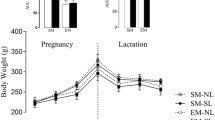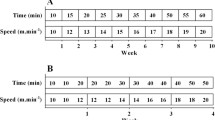Abstract
Aim
To verify whether moderate physical training affects the muscle fibre composition of adult rats subjected to a low protein diet during the perinatal period.
Methods
Male Wistar rats were divided into two groups according to their mother’s diet during gestation and lactation: control (17% casein, C) and low-protein (8% casein, LP). On postnatal day 60, half of each group was submitted to moderate physical training (8 weeks, 5 days/week−1, 60 min/day−1, at 70% of VO2max, T) or not. After the physical training period, soleus and extensor digitorum longus (EDL) muscles were removed. Myofibrillar ATPase staining was used to classify muscle fibres as type I, IIa, IIb, and intermediate.
Results
In the EDL muscle, LP rats showed no changes in the fibre type proportion. Both the C + T and LP + T groups showed a higher percentage of fibres of type IIa, and a lower proportion of fibres of type IIb. In the soleus muscle, LP animals showed a reduction in the proportion of fibre types I and intermediate. C + T rats showed an increase in the fibre type I and IIa. In the LP + T rats, the proportions of the fibre types remained similar to control rats.
Conclusions
Moderate physical training acts as a positive environmental stimulus that reverts the effects of a perinatal low-protein diet on the proportion of fibre types in skeletal muscle.



Similar content being viewed by others
References
Rasmussen EL, Malis C, Jensen CB, Jensen JE, Storgaard H, Poulsen P, Pilgaard K, Schou JH, Madsbad S, Astrup A, Vaag A (2005) Altered fat tissue distribution in young adult men who had low birth weight. Diabetes Care 28:151–153
Ravelli GP, Stein ZA, Susser MW (1976) Obesity in young men after famine exposure in utero and early infancy. N Engl J Med 295:349–353
Brameld JM (2004) The influence of undernutrition on skeletal muscle development. Br J Nutr 91:327–328
Bedi KS, Birzgalis AR, Mahon M, Smart JL, Wareham AC (1982) Early life undernutrition in rats. 1. Quantitative histology of skeletal muscles from underfed young and refed adult animals. Br J Nutr 47:417–431
Wilson SJ, Ross JJ, Harris AJ (1988) A critical period for formation of secondary myotubes defined by prenatal undernourishment in rats. Development 102:815–821
Toscano AE, Manhaes-de-Castro R, Canon F (2008) Effect of a low-protein diet during pregnancy on skeletal muscle mechanical properties of offspring rats. Nutrition 24:270–278
Bayol S, Jones D, Goldspink G, Stickland NC (2004) The influence of undernutrition during gestation on skeletal muscle cellularity and on the expression of genes that control muscle growth. Br J Nutr 91:331–339
de Melo JF, Aloulou N, Duval JL, Vigneron P, Bourgoin L, Leandro CG, de Castro CM, Nagel MD (2011) Effect of a neonatal low-protein diet on the morphology of myotubes in culture and the expression of key proteins that regulate myogenesis in young and adult rats. Eur J Nutr 50(4):243–250
Hanson MA, Gluckman PD (2005) Developmental processes and the induction of cardiovascular function: conceptual aspects. J Physiol 565:27–34
Rockl KS, Hirshman MF, Brandauer J, Fujii N, Witters LA, Goodyear LJ (2007) Skeletal muscle adaptation to exercise training: AMP-activated protein kinase mediates muscle fiber type shift. Diabetes 56:2062–2069
Leandro CG, Levada AC, Hirabara SM, Manhaes-de-Castro R, De-Castro CB, Curi R, Pithon-Curi TC (2007) A program of moderate physical training for Wistar rats based on maximal oxygen consumption. J Strength Cond Res 21:751–756
Hirabara SM, Silveira LR, Abdulkader FR, Alberici LC, Procopio J, Carvalho CR, Pithon-Curi TC, Curi R (2006) Role of fatty acids in the transition from anaerobic to aerobic metabolism in skeletal muscle during exercise. Cell Biochem Funct 24:475–481
Bigard AX, Janmot C, Sanchez H, Serrurier B, Pollet S, d’Albis A (1999) Changes in myosin heavy chain profile of mature regenerated muscle with endurance training in rat. Acta Physiol Scand 165:185–192
Stone J, Brannon T, Haddad F, Qin A, Baldwin KM (1996) Adaptive responses of hypertrophying skeletal muscle to endurance training. J Appl Physiol 81:665–672
Roy RR, Talmadge RJ, Fox K, Lee M, Ishihara A, Edgerton VR (1997) Modulation of MHC isoforms in functionally overloaded and exercised rat plantaris fibers. J Appl Physiol 83:280–290
Bayne K (1996) Revised guide for the care and use of laboratory animals available. American physiological society. Physiologist 39:199, 208–211
Reeves PG, Nielsen FH, Fahey GC Jr (1993) AIN-93 purified diets for laboratory rodents: final report of the American Institute of Nutrition ad hoc writing committee on the reformulation of the AIN-76A rodent diet. J Nutr 123:1939–1951
Pestronk GJ, Kaiser KK, Brooke MH (1992) ATPase stain in muscle histochemistry. Muscle Nerve 15:258
Brooke MH, Kaiser KK (1970) Muscle fiber types: how many and what kind? Arch Neurol 23:369–379
Passos MC, da Fonte Ramos C, Dutra SC, Mouco T, de Moura EG (2002) Long-term effects of malnutrition during lactation on the thyroid function of offspring. Horm Metab Res 34:40–43
Mallinson JE, Sculley DV, Craigon J, Plant R, Langley-Evans SC, Brameld JM (2007) Fetal exposure to a maternal low-protein diet during mid-gestation results in muscle-specific effects on fibre type composition in young rats. Br J Nutr 98:292–299
Ozanne SE, Hales CN (2004) Lifespan: catch-up growth and obesity in male mice. Nature 427:411–412
Bol VV, Reusens BM, Remacle CA (2008) Postnatal catch-up growth after fetal protein restriction programs proliferation of rat preadipocytes. Obesity (Silver Spring) 16:2760–2763
Bieswal F, Ahn MT, Reusens B, Holvoet P, Raes M, Rees WD, Remacle C (2006) The importance of catch-up growth after early malnutrition for the programming of obesity in male rat. Obesity (Silver Spring) 14:1330–1343
Barker DJ (1999) Early growth and cardiovascular disease. Arch Dis Child 80:305–307
Fiebig RG, Hollander JM, Ney D, Boileau R, Jeffery E, Ji LL (2002) Training down-regulates fatty acid synthase and body fat in obese Zucker rats. Med Sci Sports Exerc 34:1106–1114
Wong PC, Chia MY, Tsou IY, Wansaicheong GK, Tan B, Wang JC, Tan J, Kim CG, Boh G, Lim D (2008) Effects of a 12-week exercise training programme on aerobic fitness, body composition, blood lipids and C-reactive protein in adolescents with obesity. Ann Acad Med Singapore 37:286–293
Punkt K, Naupert A, Asmussen G (2004) Differentiation of rat skeletal muscle fibres during development and ageing. Acta Histochem 106:145–154
Fahey AJ, Brameld JM, Parr T, Buttery PJ (2005) The effect of maternal undernutrition before muscle differentiation on the muscle fiber development of the newborn lamb. J Anim Sci 83:2564–2571
Ozanne SE, Hales CN (2002) Early programming of glucose-insulin metabolism. Trends Endocrinol Metab 13:368–373
Jensen CB, Storgaard H, Madsbad S, Richter EA, Vaag AA (2007) Altered skeletal muscle fiber composition and size precede whole-body insulin resistance in young men with low birth weight. J Clin Endocrinol Metab 92:1530–1534
Pette D, Staron RS (1997) Mammalian skeletal muscle fiber type transitions. Int Rev Cytol 170:143–223
Gallo M, MacLean I, Tyreman N, Martins KJ, Syrotuik D, Gordon T, Putman CT (2008) Adaptive responses to creatine loading and exercise in fast-twitch rat skeletal muscle. Am J Physiol Regul Integr Comp Physiol 294:R1319–R1328
Putman CT, Xu X, Gillies E, MacLean IM, Bell GJ (2004) Effects of strength, endurance and combined training on myosin heavy chain content and fibre-type distribution in humans. Eur J Appl Physiol 92:376–384
Kariya F, Yamauchi H, Kobayashi K, Narusawa M, Nakahara Y (2004) Effects of prolonged voluntary wheel-running on muscle structure and function in rat skeletal muscle. Eur J Appl Physiol 92:90–97
Pogrzebna M, Celichowski J (2008) Changes in the contractile properties of motor units in the rat medial gastrocnemius muscle after one month of treadmill training. Acta Physiol (Oxf) 193:367–379
Harridge SD (2007) Plasticity of human skeletal muscle: gene expression to in vivo function. Exp Physiol 92:783–797
Freitas-Silva SR, Manhaes-de-Castro R, Perot C (2008) Is the maturation of monosynaptic stretch reflex in rats affected by neonatal malnutrition? Nutr Neurosci 11:207–212
Acknowledgments
The authors are indebted to Lucia Pires for technical assistance, and to Edeones França. This research was supported by the Foundation to Support Science and Research in Pernambuco State—Brazil (FACEPE) and the National Council for Research—Brazil (CNPq).
Conflict of interest
The authors declare that there are no conflicts of interest.
Author information
Authors and Affiliations
Corresponding author
Rights and permissions
About this article
Cite this article
Leandro, C.G., da Silva Ribeiro, W., dos Santos, J.A. et al. Moderate physical training attenuates muscle-specific effects on fibre type composition in adult rats submitted to a perinatal maternal low-protein diet. Eur J Nutr 51, 807–815 (2012). https://doi.org/10.1007/s00394-011-0259-3
Received:
Accepted:
Published:
Issue Date:
DOI: https://doi.org/10.1007/s00394-011-0259-3




